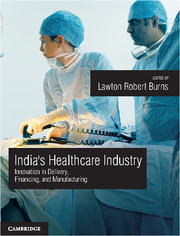Book contents
- Frontmatter
- Contents
- List of Figures
- Preface
- Acknowledgments
- SECTION I Introduction: Lenses and Frameworks for Analyzing India's Healthcare System
- SECTION II Providers: Delivery of Healthcare Services
- SECTION III Payers: Financing of Healthcare Services
- SECTION IV Producers: Manufacturers of Healthcare Technology
- 13 The Indian Pharmaceutical Sector: The Journey from Process Innovation to Product Innovation
- 14 India's Biotechnology Sector
- 15 The Medical Device Sector in India
- 16 Balancing Access and Innovation in Developing Countries
- Contributors
- Index
15 - The Medical Device Sector in India
Published online by Cambridge University Press: 05 June 2014
- Frontmatter
- Contents
- List of Figures
- Preface
- Acknowledgments
- SECTION I Introduction: Lenses and Frameworks for Analyzing India's Healthcare System
- SECTION II Providers: Delivery of Healthcare Services
- SECTION III Payers: Financing of Healthcare Services
- SECTION IV Producers: Manufacturers of Healthcare Technology
- 13 The Indian Pharmaceutical Sector: The Journey from Process Innovation to Product Innovation
- 14 India's Biotechnology Sector
- 15 The Medical Device Sector in India
- 16 Balancing Access and Innovation in Developing Countries
- Contributors
- Index
Summary
Introduction: What are medical devices?
There are various definitions of “medical devices” or, more broadly, “medical equipment.” Following the widely accepted definition advanced by the US Food and Drug Administration (USFDA), medical devices range from simple instruments such as tongue depressors and bedpans to more technologically complex pacemakers and implantable devices, but exclude pharmaceuticals. Medical devices also encompass in vitro diagnostic products, such as general-purpose lab equipment, reagents, and test kits, which may include monoclonal antibody technology. Specifically, the USFDA defines a medical device as
“an instrument, apparatus, implement, machine, contrivance, implant, in vitro reagent, or other similar or related article, including a component part, or accessory” that, in addition to other criteria, is “intended to affect the structure or any function of the body of man or other animals, and which does not achieve any of its primary intended purposes through chemical action within or on the body of man or other animals and which is not dependent upon being metabolized for the achievement of any of its primary intended purposes.”
For the purpose of this chapter, we use the above definition and the terms “medical devices” and “medical equipment” interchangeably. As noted, medical devices can span several functions and therapeutic areas.
- Type
- Chapter
- Information
- India's Healthcare IndustryInnovation in Delivery, Financing, and Manufacturing, pp. 500 - 537Publisher: Cambridge University PressPrint publication year: 2014



